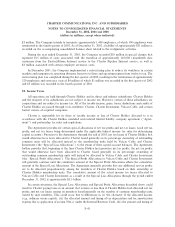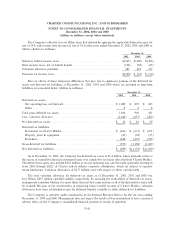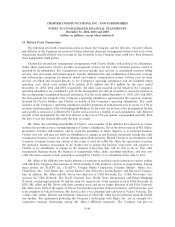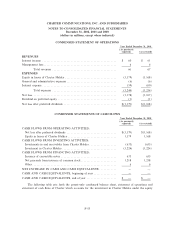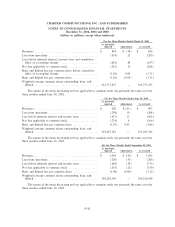Charter 2002 Annual Report Download - page 117
Download and view the complete annual report
Please find page 117 of the 2002 Charter annual report below. You can navigate through the pages in the report by either clicking on the pages listed below, or by using the keyword search tool below to find specific information within the annual report.CHARTER COMMUNICATIONS, INC. AND SUBSIDIARIES
NOTES TO CONSOLIDATED FINANCIAL STATEMENTS
December 31, 2002, 2001 and 2000
(dollars in millions, except where indicated)
Charter has directors' and oÇcers' liability insurance coverage that it believes is available for these
matters, subject to the terms, conditions and limitations of the respective policies.
Regulation in the Cable Industry
The operation of a cable system is extensively regulated by the Federal Communications Commission
(FCC), some state governments and most local governments. The FCC has the authority to enforce its
regulations through the imposition of substantial Ñnes, the issuance of cease and desist orders and/or the
imposition of other administrative sanctions, such as the revocation of FCC licenses needed to operate certain
transmission facilities used in connection with cable operations. The 1996 Telecom Act altered the regulatory
structure governing the nation's communications providers. It removed barriers to competition in both the
cable television market and the local telephone market. Among other things, it reduced the scope of cable rate
regulation and encouraged additional competition in the video programming industry by allowing local
telephone companies to provide video programming in their own telephone service areas.
The 1996 Telecom Act required the FCC to undertake a number of implementing rulemakings.
Moreover, Congress and the FCC have frequently revisited the subject of cable regulation. Future legislative
and regulatory changes could adversely aÅect the Company's operations.
The 1992 Cable Act permits certiÑed local franchising authorities to order refunds of basic service tier
rates paid in the previous twelve-month period determined to be in excess of the maximum permitted rates.
During the years ended December 31, 2002, 2001 and 2000, the amounts refunded by the Company have been
insigniÑcant. The Company may be required to refund additional amounts in the future.
25. Employee BeneÑt Plan
The Company's employees may participate in the Charter Communications, Inc. 401(k) Plan. Employ-
ees that qualify for participation can contribute up to 50% of their salary, on a pre-tax basis, subject to a
maximum contribution limit as determined by the Internal Revenue Service. The Company matches 50% of
the Ñrst 5% of participant contributions. The Company made contributions to the 401(k) plan totaling
$8 million, $9 million and $7 million for the years ended December 31, 2002, 2001 and 2000, respectively.
26. Recently Issued Accounting Standards
Statement of Financial Accounting Standards (SFAS) No. 143, ""Accounting for Asset Retirement
Obligations,'' addresses Ñnancial accounting and reporting for obligations associated with the retirement of
tangible long-lived assets and the associated asset retirement costs. SFAS No. 143 is eÅective for Ñscal years
beginning after June 15, 2002. The Company will adopt SFAS No. 143 on January 1, 2003. The Company
does not expect the adoption of SFAS No. 143 to have a material impact on the Company's Ñnancial
condition or results of operations.
In April 2002, the Financial Accounting Standards Board (FASB) issued SFAS No. 145, ""Rescission of
FASB Statements No. 4, 44, and 64, Amendment of FASB Statement No. 13, and Technical Corrections.''
SFAS No. 145 provides for the rescission of several previously issued accounting standards, new accounting
guidance for the accounting for certain lease modiÑcations and various technical corrections that are not
substantive in nature to existing pronouncements. The Company will adopt SFAS No. 145 beginning
January 1, 2003, except for the provisions relating to the amendment of SFAS No. 13, which will be adopted
for transactions occurring subsequent to May 15, 2002. The Company does not expect the adoption of SFAS
No. 145 to have a material impact on the consolidated Ñnancial statements of the Company.
F-49




